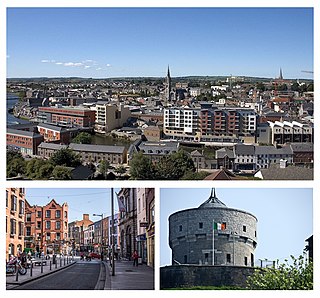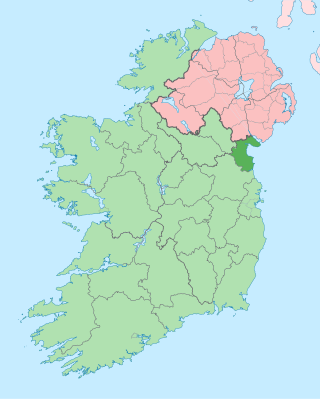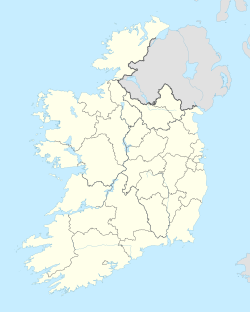
Drogheda is an industrial and port town in County Louth on the east coast of Ireland, 43 km (27 mi) north of Dublin city centre. It is located on the Dublin–Belfast corridor on the east coast of Ireland, mostly in County Louth but with the south fringes of the town in County Meath, 40 km (25 mi) north of Dublin city centre. Drogheda had a population of 44,135 inhabitants in 2022, making it the eleventh largest settlement by population in all of Ireland, and the largest town in Ireland, by both population and area. It is the second largest in County Louth with 35,990 and sixth largest in County Meath with 8,145. It is the last bridging point on the River Boyne before it enters the Irish Sea. The UNESCO World Heritage Site of Newgrange is located 8 km (5.0 mi) west of the town.

Dundalk is the county town of County Louth, Ireland. The town is situated on the Castletown River, which flows into Dundalk Bay on the north-east coast of Ireland, and is halfway between Dublin and Belfast, close to and south of the border with Northern Ireland. It is surrounded by several townlands and villages that form the wider Dundalk Municipal District. It is the seventh largest urban area in Ireland, with a population of 43,112 as of the 2022 census.

County Louth is a coastal county in the Eastern and Midland Region of Ireland, within the province of Leinster. Louth is bordered by the counties of Meath to the south, Monaghan to the west, Armagh to the north and Down to the north-east, across Carlingford Lough. It is the smallest county in Ireland by land area and the 17th most populous, with just over 139,100 residents as of 2022. The county is named after the village of Louth. Louth County Council is the local authority for the county.

Pádraig Faulkner was an Irish Fianna Fáil politician who served as Ceann Comhairle of Dáil Éireann from 1980 to 1981, Minister for Defence 1979 to 1980, Minister for Posts and Telegraphs and Minister for Tourism and Transport from 1977 to 1979, Minister for Education from 1969 to 1973, Minister for the Gaeltacht and Minister for Lands from 1968 to 1969 and Parliamentary Secretary to the Minister for the Gaeltacht from 1965 to 1968. He served as a Teachta Dála (TD) for the Louth constituency from 1957 to 1987.

Ardee is a town and townland in County Louth, Ireland. It is located at the intersection of the N2, N52, and N33 roads. The town shows evidence of development from the thirteenth century onward but as a result of the continued development of the town since then much of the fabric of the medieval town has been removed. The town is in a civil parish of the same name.

Blackrock is a seaside village just to the south of Dundalk, County Louth, Ireland. The village is in the townland of Haggardstown, in the Barony of Upper Dundalk, and part of the Dundalk metropolitan area. The population of the village is approximately 3,000.

Laytown is a village in County Meath, Ireland, located on the R150 regional road and overlooking the Irish Sea. Historically it was called Ninch, after the townland it occupies. Together with the neighbouring villages of Mornington, Bettystown and Donacarney, it comprises the census town of Laytown–Bettystown–Mornington–Donacarney, which recorded a population of 15,642 in the 2022 census.

Kingscourt, historically known as Dunaree, is a town in County Cavan, Ireland. It is located near the Cavan–Meath border. The town was founded near the site of the old village of Cabra, by Mervyn Pratt, towards the end of the 18th century, and was completed by his brother, the Reverend Joseph Pratt. As of the 2022 census, the population was 2,955.

Baltray is a village and townland in County Louth, Ireland. It sits on the northern shore of the River Boyne estuary.

Bettystown, previously known as Betaghstown and transliterated to Beattystown/Bettystown, is a village in County Meath, Ireland. Together with the neighbouring villages of Laytown, Mornington and Donacarney, it comprises the urban area of Laytown–Bettystown–Mornington–Donacarney with a combined population of 15,642 at the 2022 census. During the Celtic Tiger, with increasing property prices in Dublin, Bettystown expanded to cater for large numbers of commuters to Dublin. The area was well known before that as a spot for Dublin summer holiday visitors, with a number of caravan parks and seaside amusements.

Tinure, also Tenure, is a small village and townland in the parish of Monasterboice, County Louth, Ireland.

Annagassan is a village in the townland of Ballynagassan, County Louth, Ireland. It sits where the River Glyde enters the Irish Sea. It is approximately 16km south of Dundalk and 22km north of Drogheda. As of the 2022 census, Annagassan had a population of 189 people.

Donore, historically Dunower, is a small village in County Meath, Ireland. It lies near Drogheda on the border between County Meath and County Louth, in the Boyne Valley on the road between Drogheda and the Brú na Bóinne heritage site. The village is in a civil parish of the same name.

Dunleer railway station is a disused railway station on the Dublin-Belfast railway line in Dunleer, County Louth Ireland. Opened by the Dublin and Belfast Junction Railway in 1851, the station was the major stop between Dundalk and Drogheda. The station survived longer than most following the rationalisation of the railway network, until it was closed by Córas Iompair Éireann in 1984.
Hunterstown Rovers is a Gaelic football (GAA) club located in Ardee, County Louth, Ireland. The club's pitch is located about 3 kilometres south of Ardee on the main Dublin-Derry Road (N2). Hunterstown has teams at all age levels starting from U5's through to senior level.
Bus Éireann Route 101 is a bus route in Ireland, that runs from Talbot Street, in Dublin city centre, to the Bus Station in the town of Drogheda, via Swords, Balbriggan and Julianstown. It is operated by Bus Éireann and is the main bus route connecting Drogheda to Dublin. Routes 101X and 100X are peak time express services using the Dublin Port Tunnel and M1 motorway. In 2023 the 101 route was upgraded to a full 24-hour service from Sunday May 7th, with 293 departures targeted per week. The new timetable is operated by Bus Eireann and includes a fleet of new, fully accessible double and single deck coaches on the route.
The Louth Minor Football Championship is an annual competition organised by Louth GAA between the premier teams in minor (under-17) Gaelic football in County Louth.
Lann Léire CPG is a Gaelic Athletic Association (GAA) club that fields gaelic football teams in competitions organised by Louth GAA. It is based in the County Louth town of Dunleer. The club plays home matches at Páirc Uí Mhuirí, named after Larry Murray, the Louth priest who made a significant contribution to GAA affairs in the county and elsewhere.
St Kevin's GAA is a Gaelic Athletic Association (GAA) club that fields teams in competitions organised by Louth GAA. It is located in the townland of Philipstown, just over 2 miles from the town of Dunleer in mid-Louth.
The Louth Intermediate Football League is an annual Gaelic football competition organised by Louth GAA for Division 2 teams in County Louth.




















